Before I get into my Tesla Powerwall review, I’d like to share a bit of my background. As a young and middle-aged man I was not overly conscious about the environment, but towards the end of my career as a civil engineer I became more and more aware about the environment and the sustainable measures we used to mitigate the impact of road renewal and development.
Now that I am retired, I have a greater and growing desire to be more aware of our precious environment and to do everything I can to reduce the impact of my life on the planet. To this end my target is (as much as possible) to be carbon neutral and I have six goals on this journey, which are linked and interconnected:
- Stop using natural gas for cooking and heating
- Stop using an internal combustion engine for powered transport
- Install solar power
- Install battery storage
- Install an air source heat pump
- Use an electric vehicle
I have made modest in-roads into these goals with an induction hob and electric oven, and the installation of a solar PV array with battery storage. Later this year I will replace my gas boiler with an air source heat pump and, when finances permit, I will get an electric vehicle.
Tesla Powerwall review
This review is principally concerned with solar production, battery storage and its overall impact. As many of you will know solar power is an abundant, free and clean source of power. However, it is frequently in abundance when you can’t make use of it yourself and it is not available at night or frequently during the long, cold winters we experience across the UK.
Until now, the principle use for solar appears to be reducing the use of grid electricity during the day with excess being either used to heat hot water in storage tanks or exporting it to the grid with some users employing battery storage in order to use solar generated power during the evening.
Many pioneers have experimented with various battery options over the last decades with mixed results. Today, battery technology has improved and continues to improve at pace. Batteries are becoming cheaper and more reliable with increased life, probably as a result in the development of electric vehicle technologies.
After considerable research and discussions with Home Energy Scotland (Energy Savings Trust) and my chosen installer, Solar and Wind Applications, I decided on an array of LG solar panels managed through a SolarEdge inverter with two Tesla Powerwalls, controlled by a Tesla Gateway.

The gateway has three input sources (solar, grid and Powerwall) and three outputs (backed-up supply, non-backed up supply and Powerwalls). The non-backed up power is a circuit which you deem unnecessary during a power cut. This might be garden lights or garage mains circuit, or any non-essential power circuit. If there is a fault in your grid supply and its cut off, then the gateway instantaneously switches to the Tesla Powerwall and your backup circuit continues as normal fed purely from the Powerwall, solar or both.
It is possible to observe the circuit at all times via the Tesla Lifestyle app. The app also shows you the current state of your battery pack and allows you to view the Power Flow, Performance, Backup History and to Customise your system.
Power Flow allows you to look at the current collective flow (or each individual flow) and performance over the day, week, month, year or lifetime of your system. All data can also be downloaded as a CSV file to be analysed later.
Performance presents you with a pie chart of how the solar and Tesla Powerwall have performed on a particular day, week, month or lifetime. The system also lets you View Peak, Partial-Peap and Off-Peak performance.
Backup History simply lists the periods the system has been off grid, so this gives you something to think about regarding your reserve battery capacity for power cuts. It is difficult to put an economic value on the backup, but in my circumstances I really can’t afford to be without electricity and this is therefore a key element for me.
Customize allows you to dictate how your Powerwalls will be used. Backup-only, Self Powered (only use Powerwall after sunset) or Advanced. The app also allows you to define the percentage of power you wish to reserve for backup; basically, how much do you want retained in the Powerwalls to cater for power cuts.
The Advanced setting allows two setup options, either Balanced (daylight/nighttime) or Cost Saving (flexible peak and off peak), telling the gateway when and when not to take power from the grid. This permits time-shifting of your electricity, purchasing electricity during off peak, less expensive times, and store this in the Powerwall for use during peak periods when power is expensive.
Obviously these settings require a smart meter and a supplier that offers a flexible tariff. I use Octopus Agile which gives varying tariffs at half hour slots during any 24 hour period. My average tariff has been 9p/kWh between December and March, 2021. This functionality of controlling the generation and purchasing of power, which is then stored to be utilised at any time, was a key element in my decision to install this system.
The SolarEdge app gives more details pertaining to the performance of each individual panel.
Air source heat pumps are more efficient than gas boilers, but gas is considerably cheaper than electricity. To this end, an air source heat pump will use a large amount of electricity and with storage I should be able to help bridge the cost gap by time-shifting the draw from the grid and utilising surplus solar better, thereby improving the cost effectiveness of the system as a whole.
Return on investment
I concur that the Tesla Powerwall set up is expensive. For one installed Powerwall plus Gateway I was quoted £9,200, and £15,200 for two Powerwalls plus Gatweway.
I am the first to admit that I will have to utilise a lot of stored electricity to pay that back and that might be a tough ask. However, all the Tesla kit comes with a 10 year warranty, so it’s a long-term valuation exercise which I look forward to analysing from actual data as my system develops and runs over time.
In order to make a reasonable attempt at calculating return on investment, I will consider a number of areas including location, setup, projected solar power, cost of importing power from the grid and return from exporting power to the grid.
I live in the south-west of Scotland, some 35 miles south of Glasgow. Available information I have found all relates to Glasgow, but I don’t consider the geographic variance to be overly significant. My solar panel array consists of 14 LG 380 watt panels totalling to 5.32kW. The following table is my attempt at predicting the actual output of the system.
| Solar irradiance for Glasgow* | Daily output kWh | Monthly output kWh |
| 0.57 | 2.274 | 70.503 |
| 1.27 | 5.067 | 141.884 |
| 2.27 | 9.057 | 280.776 |
| 3.65 | 14.564 | 436.905 |
| 4.99 | 19.910 | 617.213 |
| 5.12 | 20.429 | 612.864 |
| 4.72 | 18.833 | 583.817 |
| 4.01 | 16.000 | 495.997 |
| 2.72 | 10.853 | 325.584 |
| 1.46 | 5.825 | 180.587 |
| 0.72 | 2.873 | 86.184 |
| 0.38 | 1.516 | 47.002 |
| Total | 3879.317 |
The Efficient Energy Saving website suggests the following: “To calculate the amount of solar energy you will get from a photovoltaic solar panel for an average day in any given month, multiply the stated wattage of the solar panel by 75% (to account for inefficiencies in the power generation and capture) and then multiply it by the kWh/day figure for the month in question.”
As a comparison, my actual figures were 58.7kWh for December, 99.8kWh for January and 186kWh for February, 2021.
Next, I had to calculate my energy consumption based on how my house performs on average:
| Previous average electricity usage kWh | Previous average gas usage kWh | Corrected for inefficiency of 94% kWh | Mean temp. | Estimated SCOP | ASHP with SCOP kWh | Anticipated average electricity usage kWh | |
| Jan | 409 | 2388.97 | 2245.63 | 3.00 | 2.75 | 817 | 1225 |
| Feb | 356 | 2060.37 | 1936.74 | 3.50 | 2.80 | 692 | 1047 |
| Mar | 362 | 2016.79 | 1895.78 | 5.50 | 2.90 | 654 | 1016 |
| Apr | 343 | 1297.38 | 1219.54 | 7.00 | 3.00 | 407 | 750 |
| May | 387 | 805.79 | 757.44 | 10.50 | 3.00 | 252 | 639 |
| Jun | 331 | 426.02 | 400.46 | 13.00 | 3.10 | 129 | 460 |
| Jul | 342 | 319.82 | 300.63 | 15.00 | 3.00 | 100 | 442 |
| Aug | 356 | 535.17 | 503.06 | 14.50 | 3.00 | 168 | 523 |
| Sep | 348 | 781.70 | 734.80 | 11.50 | 2.90 | 253 | 602 |
| Oct | 396 | 1302.50 | 1224.35 | 9.00 | 2.90 | 422 | 818 |
| Nov | 421 | 2062.11 | 1938.38 | 6.00 | 2.80 | 692 | 1113 |
| Dec | 411 | 2331.17 | 2191.30 | 4.00 | 2.70 | 812 | 1222 |
Next, we translate that to costs:
| Est. solar power kWh | Battery storage capacity kWh | Power from grid kWh | Grid off peak kWh £0.09 | Grid mid peak kWh £0.17 | Export power with battery storage | Cost of electricity with battery storage | Export electricity without battery storage | Cost of electricity without battery storage |
| 70.50 | 753.30 | 1154.76 | 753.30 | 401.46 | £ – | £136.04 | £ – | £249.90 |
| 141.88 | 680.40 | 905.48 | 680.40 | 225.08 | £ – | £99.50 | £ – | £205.05 |
| 280.78 | 753.30 | 734.94 | 734.94 | 0.00 | £0.92 | £65.23 | £ – | £183.82 |
| 436.91 | 729.00 | 312.94 | 312.94 | 0.00 | £20.80 | £7.36 | £ – | £111.59 |
| 617.21 | 753.30 | 22.02 | 22.02 | 0.00 | £36.56 | -£34.58 | £ – | £69.43 |
| 612.86 | 729.00 | 0.00 | 0.00 | 0.00 | £44.08 | -£44.08 | £ – | £24.65 |
| 583.82 | 753.30 | 0.00 | 0.00 | 0.00 | £44.76 | -£44.76 | £7.63 | £24.42 |
| 496.00 | 753.30 | 27.44 | 27.44 | 0.00 | £36.29 | -£33.82 | £7.09 | £57.84 |
| 325.58 | 729.00 | 276.05 | 276.05 | 0.00 | £22.65 | £2.20 | £ – | £92.16 |
| 180.59 | 753.30 | 637.60 | 637.60 | 0.00 | £5.78 | £51.60 | £ – | £152.86 |
| 86.18 | 729.00 | 1027.09 | 729.00 | 298.09 | £ – | £116.29 | £ – | £224.74 |
| 47.00 | 753.30 | 1175.16 | 753.30 | 421.86 | £ – | £139.51 | £ – | £251.72 |
| £460.48 | £1,648.18 |
Since the capital investment in batteries was £15,200 and the annual saving is coming out at £1,187.70 on a crude payback calculation, it would take 12.5 years to fully recoup the investment. The batteries are guaranteed for 10 years, so the gamble would be if they would last an additional seven years (or longer).
I would say that so far my solar panels and battery storage have performed much better than the calculated estimate, but I must add that some web calculators suggest it’s nearer 20 years to break even.
This is an honest attempt to report on my system, and I am very pleased with my set up and what it delivers. I am also eager to get my air source heat pump installed as soon as possible.

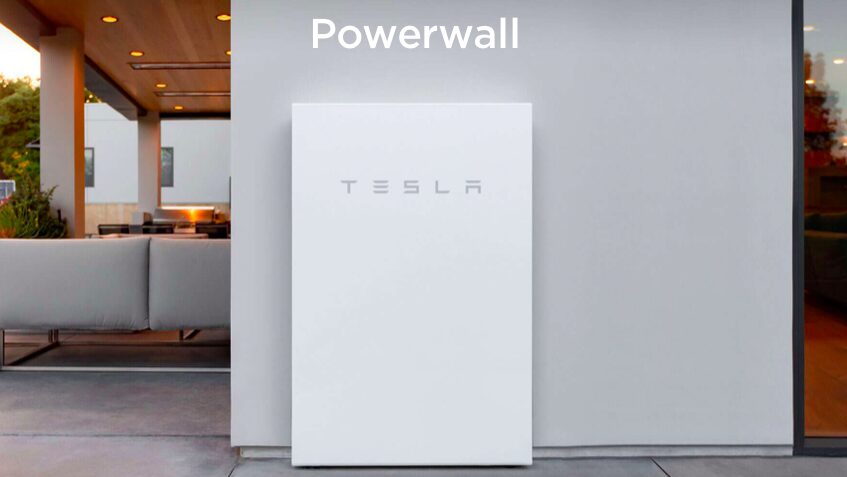
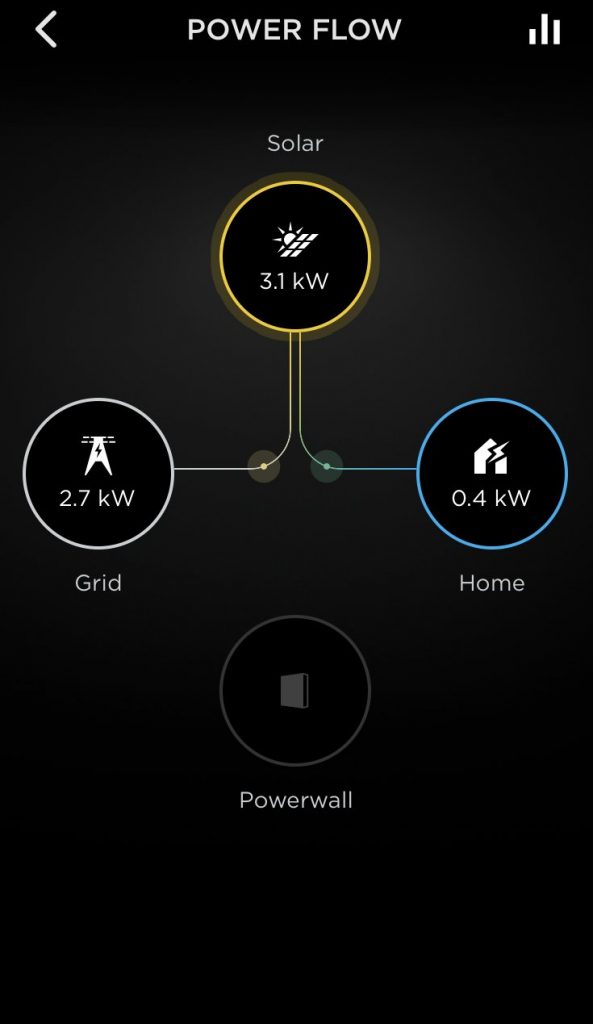
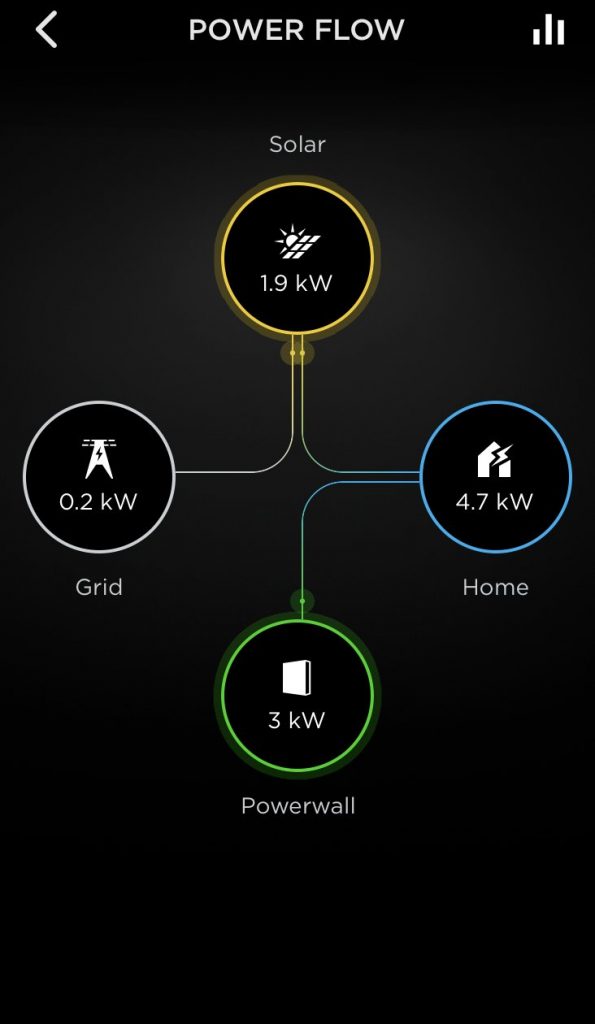
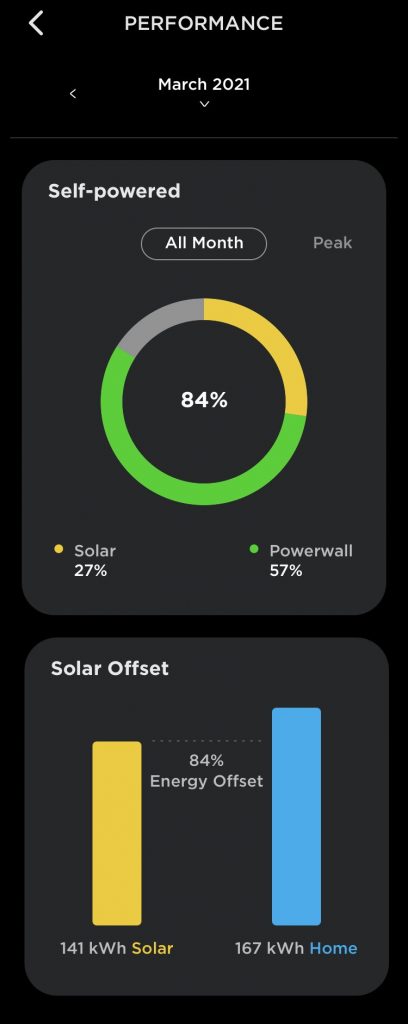
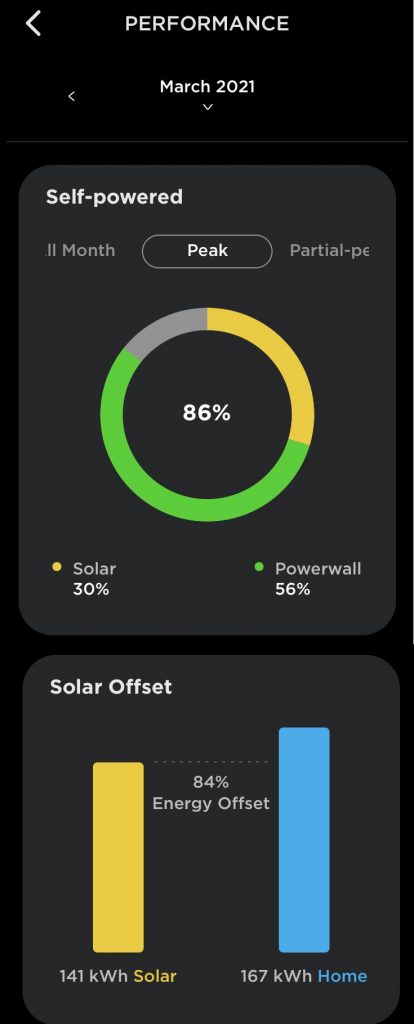
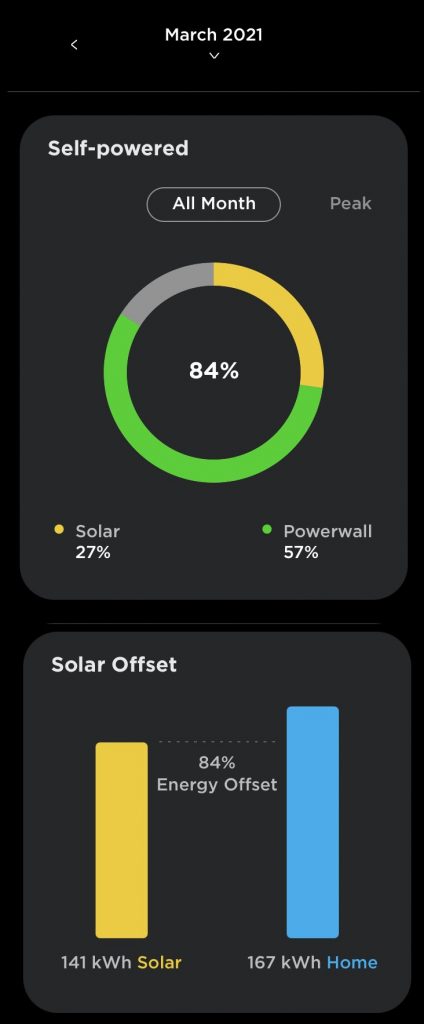

Thanks for a very interesting article explaining how your Powerwall worked, looks quite smart.
Your calculations led me to do something similar. My 4kWh PV generated 3600kWh last year (in Suffolk) so your figure of 3879 looks like a good prediction. I reckon a 15 to 20 year pay back.
What struck me was how little I could use over the summer, even with a battery. Suspect the figures look a lot better in places where running air con over night is usual.
Thanks Jon C, this is obviously a work in progress and I look forward to updating my calculations with real figures after my Air Source Heat Pump is install. You may need Air Con in Suffolk, lucky people, but it would be hard to justify for a couple of days a year in South Scotland. lol.
From some of the figures I have experimented with there is an optimum size of storage for every set up, Location / Size of Solar array / Property Heat Loss / Size of ASHP, but I’m a bit nervous to share these calcs just yet.
Clearly there isn’t a one size fits all.
I’ve managed to achieve 1, 3 & 4 of your goals so far. EV in a few years I think. Very informative article.
We installed a heat pump late in 2019 and have been happy, but the dramatic rise in the price of electricity is worrying. I anticipate our bills rising from £1500 to £2400 despite shopping around. I would like an EV but live in a terraced house with no offstreet parking. I’m wondering whether it is worth getting a battery just for the heat pump?
Katharine
Katharine as you can tell from my review batteries are an expensive investment and any return on Investment will take a long time. I am also very early in the process of real data evaluation but I have now had my Air Source Heat Pump installed and all is going as predicted, or near enough, so far. I know the overall cost of electricity is very important but depending on your kit there are some innovative tariffs now available. I have just signed up for the Tesla Energy Plan which gives me 11.16p per kWh for export and charges 11.16p per kWh import. to maximize the use of alternative tariffs I would suggest you look at Solar Panels combined with batteries. this lets you charge the batteries during the day and use the electricity from them at night as well as buying cheap electricity at night to store for use during the peak periods. Octopus Go tariff would be a reasonable start with that set up.
Hope that is of some interest.
Interesting article – similar situation here. I was going to suggest the Octopus / Tesla Energy Plan as an option.
We have Solar PV with a SolarEdge converter, ASHP, no mains gas as in the sticks. If I could get a powerwall installed now I probably would, but its seems there is a waiting list.
Our yearly usage is ~11,000 kWh, but obviously skewed to be highest in winter as per your data. Yearly production is 4.1 – 4.3 MWh; we export ~50% of that over the year. With the solaredge monitoring app I can get generation and usage data down to at least 15 min resolution and I spent some time modelling how much more self-consumption a battery would give us and subsequent cost savings.
Clearly, the new Tesla plan with a flat pay / buy rate negates any effort of personal / household smoothing of the demand curve as there is no benefit any more. By comparison, the Agile tariff looks risky; not sure what your thoughts are on this if you have operated on both.
if you want to work on an updated article with more information / data, you can likely see my email, let me know?
Jambo thanks for your positive comments, considering the Ofgem statement and predictions of the past few days I think I have just been remarkably lucky. My predicted annual bill from Octopus is now £480 per year which includes 9 months running of my heat pump and compares to £1680 based on my 2010 figures.
I now predict my return on Investment to be closer to 10 years and if gas and electricity prices continue to rise this will shorten again.
I found the Agile tariff to be a bit cumbersome when trying to predict how much to take from the grid and when. Also the rates change considerably over the 12 months I was using it.
I do believe your right about the supply of Powerwalls but unfortunately unless you have one you aren’t eligible for the Tesla energy Plan.
I may do a comparison soon between the predicted against the actual energy/ cost figures but I would like to complete the one year since install for my ASHP first.
If there is anything I can help you with in the mean time please let me know.
I too have a similar system of two Powerwalls a total of 22 solar panels on an E & W location with a solar edge inverter. We also have the complete range of myenergi controllers for charging E Niro car and heating the water. We live in the SE of England so enjoy a little more sun than in Scotland. Our next project, if we can get passed the planning nightmare, is to fit a heatpump. We’ve been quoted £8100 by octopus energy to supply and install. Frankley we will never get our money back before we shuttle off but I don’t care as we were able to do all the work from savings, they were earning a pittance in the bank. Now at least with the exception of the cars cost we are making a return on our investment of at least 7% that includes a FIT payment we receive as we got in just before the payment stopped. We could give up our FIT payment for the 50% feed in tariff and just keep the generation tariff as has been suggested, that way we could earn more from Octopus for it. However as we’ve an EV we mop up most of the Solar that would otherwise go to the grid, charging our car.
Like you we are keen to reduce our use of fossil fuel and whilst their are those who deride us because of the energy and carbon output used to manufacture this equipment, I believe most will far outlive the carbon cost and then go on to be zero carbon systems.